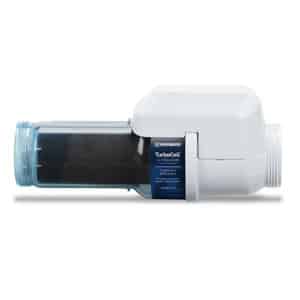If you’re a new pool owner, you may be surprised to find out how many moving parts are involved in the functioning of your pool. From pool pumps to pool heaters, there’s a wide array of parts and processes utilized to keep your pool clear, clean, and comfortable. One of those is a pool salt cell.
A pool salt cell is part of a saltwater chlorinating system. For us to understand the functionality of the pool salt cell itself, we should first understand how the system works.
Saltwater Chlorinator
Contrary to popular belief, a saltwater pool contains chlorine. A salt pool sanitizes the water with chlorine just like other pools. The difference between them is in how the chlorine is added to the pool.
A saltwater chlorinator system has two parts. The control board and the cell.

The Salt Cell For Pools
Salt cell for pools convert salt in the water into low levels of chlorine by breaking down salt molecules. The cell carries out a rather simple, natural process of electrolysis, separating the sodium and the chlorine molecules of the salt as it passes over titanium plates within the cell.
Cost of Equipment
When installing a salt chlorine generator, you can expect to pay more for the equipment and initial setup of the system.
However, the benefits of a saltwater chlorinating system are numerous. Salt pools are softer on skin, clothing, and hair. And daily pool maintenance is so much easier when you don’t have to lift heavy jugs of chlorine.
The salt cell disperses chlorine at a consistent rate whenever the pump is on, so there will be less fluctuation in water balance, making your pool easier to maintain.
For a new salt cell, you may spend between $800 and $1,000, depending on the brand.
Proper care and maintenance can extend the life of your salt cell. If maintained, a salt cell can last between 3-7 years. To ensure a long life, proper cleaning of the cell is required.
You can clean your salt cell by giving it an ‘acid bath’, which usually consists of a ratio of 90% water to 10% acid, and ‘brushing’ the calcium deposits off with a toothbrush. The acid will eat away at the plates given enough time, so be sure to bathe the cell for no longer than 10 minutes.
Troubleshooting problems:
If your salt cell is not functioning as you expect, you can troubleshoot the issue by following these steps:
1. Check Power
The salt cell is powered by a control panel. If the control panel has no indicator lights visible, there is a disconnect with the power. Many salt chlorinators also have a fuse inside the cabinet that is designed to blow intentionally, in the event of power overload or a lightning strike.
2. Check Water Flow
Salt cell for pools need a certain amount of water flow to operate effectively. Flow rates can be reduced by a clogged pump or skimmer basket, or a dirty filter, or closed directional valves.
3. Check Salt Level
The salt cell needs a certain amount of salt in the water to be able to convert it to chlorine. Each salt cell is calibrated to work within a certain range of salinity, generally around 4000 ppm.
Most salt chlorinators use a salt sensor that displays the measured salt level while some models give an indicator light or error code to let you know when the salt level drops below the minimum threshold.
4. Check Water Balance
Your pool chemicals should all be within range so that the created chlorine will run with optimal efficiency. A low pH can accelerate the activity of chlorine, burning it off more rapidly, while a high pH can reduce the activity, making your chlorine sluggish and less effective.
It’s important to test for chemical levels anytime you suspect an issue with your chlorinator.
5. Inspect the Salt Cell
The salt cell needs to be cleaned regularly to remove calcium deposits which can slow water flow. The majority of salt cell chlorinators are self-cleaning by reversing polarity on the metal plates to slough off the collected calcium.
However, even self-cleaning cells need regular inspection, and, perhaps, occasional cleaning.
No matter how meticulous you may be, chances are at some point you will face a salt cell replacement. At Premier pool service, we can not only help keep your pool salt cell clean, but we are able to determine when it’s time to replace salt cell for pools.
Keeping your swimming pool functioning perfectly is not only important to the health of your family, it also protects your investment.
Why not utilize professional pool service?
Get a FREE quote
Looking to build a brand new swimming pool or add a spa or water feature to your existing pool? Check out our fantastic pool designs at premierpoolsandspas.com.



